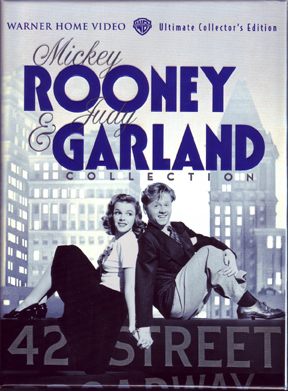
Raymond J. Steiner, Editor • Cornelia Seckel, Publisher
(845)
246-6944 · info@ArtTimesJournal.com
Rooney and Garland: Great Casts, Weak Plots
 |
By
FRANK BEHRENS
ART TIMES January February 2008
“Great
cast, lousy plot.” (A
criticism of the phone directory.)
When sound came
to Hollywood, Warner Bros. staked a lot of money and most of their reputation
on a system called Vitaphone. It consisted of a large disc on which
were recorded songs and musical numbers. This disc was hooked up to
the projector of a theatre so that the singers on the screen would be
in perfect synchronization with the sound on the recording.
Of
course, everything that could go wrong—and there were lots that
could—did go wrong. The wrong discs were sent to the theatres,
the discs skipped or got stuck so that the entire rest of the film would
be out of synchronization. (Remember that happening in the film “Singin’
in the Rain”?)
However,
“The Jazz Singer” convinced the public that talkies, especially musicals,
were here to stay; and the other studios had to go along but with a
new sound system that had the sound on the film itself. After several
years of horrible musicals, theatres had to put up signs that the featured
film was NOT a musical to draw customers back into the dark.
Still,
musicals continued to be made and among the most popular of them were
those starring Judy Garland and Mickey Rooney. Four of their most popular
efforts can now be seen in a Warner Bros. DVD boxed set of the “Mickey
Rooney & Judy Garland Collection.” For starters, there are four
discs: “Babes in Arms” (1939), “Strike Up the Band” (1940), “Babes on
Broadway” (1941), and “Girl Crazy” (1943). The first three were directed
by Busby Berkeley, the fourth partly directed by him.
These
four films are perfect examples of everything that was bad about most
musicals made since the coming of sound.
“Babes
in Arms” boasts only two Rodgers and Hart songs from the original, while
the music to a third is heard only as an ironic comment on one of the
characters. It follows the original concept, if not the entire plot,
of a group of youngsters wanting to put on a show to prove their worth.
“Where or when” is the best song in the score and the contributions
of other composers and lyricists are adequate to good. (MGM thought
the Hart lyrics to the other songs were “too sophisticated” for American
audiences. Sigh.)
“Strike
Up the Band” retains only the title and title song of the Gershwin original.
It is concerned with—surprise!—a group of youngsters
wanting to make their school band good enough to win a competition set
up by Paul Whiteman. A memorable sequence has an animated tableful of
fruits playing band music. The rest is predictable.
I
never liked Rooney in these two films. He was undoubtedly multi-talented
but his delivery was too manic for my tastes. He plays, however, the
obligatory sentimental scenes with conviction, no small feat given the
soapy dialogue. Garland is like Myrna Loy to the overacting William
Powell. She plays the “plain” girl in these first two films, finding
a rival in the blonde dancer/contortionist June Preisser.
“Babes
on Broadway” gives Garland no female rival in a plot that has—(can
you guess?)—a group of youngsters wanting to put on a show. (MGM
really had a very low opinion of the public’s taste. As long as they
gave it Rooney and Garland with impossibly overblown production numbers,
who cared about plots?)
“Girl
Crazy” is leaps better. It actually keeps seven songs from the original
play; and where other songs are interpolated, they are all by Gershwin.
The plot is sketchily that of the original: a New York playboy goes
west and has to—sorry—put on a show to help out the local
college. Garland is gorgeous in the role originally played on stage
by a teenaged Ginger Rogers, and the songs (though seldom sung in their
original context) are fabulous. (Look for a brief appearance by June
Allyson as a nightclub singer.)
MGM
has done its best to make these four films attractive by adding extra
items. Each of the four films is followed by several bonus features.
The first and last films have excellent, highly informative optional
narrations by John Fricke. They all have vintage cartoon and shorts
to give that Saturday Afternoon at the Movies feel.
There
is a hard cover booklet giving a history of the films, along with the
casts and trackings. With the book is yet a fifth DVD which holds an
interview with Mickey Rooney, a compilation of 22 Garland songs from
several of her films, and 10 trailers for Rooney and Garland films.
There is even a boxed collection of stills taken at off-moments during
the shooting of the four films.
What
a glorious packaging for the same plot being used four times! Yet, in
a way, the studio was correct. If the public accepted predictable plots,
why bother to give them better ones? You pays your money and … so on.